#Server Routing Protocol Homework Help
Explore tagged Tumblr posts
Text
Computer Network Homework Help
Help for computer network assignment | Help for computer network homework
If you are an aspiring computer engineering aspiring and are looking for help with tasks for your computer networking subject, then you may be looking for different help for offline and online tasks. However, choosing the right help that can provide you with a complete task on time is not an easy task. Here we will inform you about the different topics covered in the assignment of computer networks and finally we will give you a perfect option to select for your computer network homework help.
To provide a quick exit for your teacher with a complete understanding of the task and consequently get better grades it is important that students choose the task with different features such as professionalism, good editing skill, exclusive content and no ordeal, and so on. If you can find all these important features, then finally you need to compare the prices and topic that they can cover for the desired subject, such as computer networks. For your help in assigning computer network, all assignment experts can be a choice you can trust.
About Computer Network homework Help
The computer network is one of the most essential and interesting disciplines for students of electronics and computer engineering. This topic is at the core and provides complete information about how prevailing communication systems, such as wired and wireless communication networks. All components used, the different types of topology used and all the essential concepts relating to the technical aspects of networking with the computer are explained in detail in this subject. Different terminologies used in the computer network are mentioned below. Based on this, there are numerous assignments and projects are given to students:
In generic terms, they are divided into the form of wired, wireless, and distributed and undistributed networks.
The computer network can be defined as the set of computers also known as nodes that are connected using wires or wireless media.
The primary purpose of networking between the computer is the sharing of information and resources. With the help of the shared network, you can share resources and information. You can create files on one computer and access them on another.
There are different types of topologies, such as star, mesh, bus, and ring topologies, that are used to establish the network.
Routers, cables, distributors, network cards (internal and external), and USB are some of the necessary hardware that is used to establish a network. Network interfaces, firewall, repeaters, hubs, bridges, switches, and modems are the necessary hardware that has made it possible for the Internet to function as the computer to the network.
Different protocols are used for communication on computer networks such as TCP/IP and more. We are mentioning protocols here because computer networking is a generic term that is used. However, the World Wide Web is also a type of computer network on which different servers and computers are connected on a large scale that uses the different set of algorithms and protocols to work with.
There are different types of computer networks, such as LAN, MAN, WAN, VPN, backbone network, Internet and Intranet with extranet, and so on. Let's discuss these networks in summary:
LAN means the local network of acres that is valid up to a limited area, such as in a building or in any institution.
MAN represents the metropolitan network that exists in areas such as a small town or village. The cable network used for TV broadcasting is MAN type.
WAN means area network that covers a wide area. The Internet is one of the examples of WAN.
VPN is the virtual private network that comes in the application when members of the company or group of computers form a network so that they can share the different files and other resources needed. VPN are widely used to gain access to multiple sites that are not allowed to open in a specific area or on a particular server
The Internet is the WAN or the global network, which is widely used for different applications such as search, download, upload and so on.
However, the intranet is valid only as small LAN, MAN, or VPN. It cannot be considered as WAN because not everyone can access the network. It is a private network with authorization only for some people.
Wired, wireless and exotic technologies are currently being used for communication over the computer network
When you are in high school or undergraduate school, you may have to present some of the basic concepts and their functioning in the form of attribution. However, if you are studying in higher classes, such as PG or PhD, you may have to do research on the wireless network (the most common currently) or other relevant and new concept and bring something new to your dissertation. Your computer systems-based thesis is quite complex, as you will not only have to formulate something new, but you will also have to prove it. This is where you want to get help with the computer network homework.
How can All Assignments experts help you with the help of Network Assignment?
Well, the answer is simple. We have a set of experienced professionals who are not only useful for finding unique content, but also able to offer you timely delivery of the content. You can complete your work on time. The Computer Networks project will be a piece of cake when you contact all task experts.
With the help of simple steps, you'll be able to get the best out of all task experts. Not only are we required to give you the assignments, but we guarantee to guide you with all the important concepts that have been used within it. So, what are you waiting for? Register with all task specialists now!
Popular topics students are looking to us for online help for are:
COMPUTER NETWORK HOMEWORK HELP
Advanced multicast routing models Analog data for digital signals
Campus Area Network (CAN) application layer
Data Link Layer Congestion Control Techniques
Dynamic Host Configuration Protocol (DHCP) IEEE 802.4: Network Token Bus
IPV4 and IPV6 Internet Protocols
LAN (Local Network) Layer Network Architecture -OSI 7
Man (Metropolitan Area Network) media converters
Network Devices - Hub, Repeater, Modem Network Interface Card (NIC)
Network layer Network management and security
Network topologies and layered network and architecture networks
Router and SWITCHES PAN (Personal Area Network)
Storage Area Network (SAN) routing algorithms
Area network of the system of programming of soques
Transmission medium and topology Transport layer
WAN (Wide Area Network) WLAN (Wireless Local Area Network)
0 notes
Text
Server Routing Protocol Homework Assignment Help
Server Routing Protocol (SRP) is the proprietary network protocol used to transfer data between a Server and the Research in Motion BlackBerry infrastructure. We cater 24x7 hour customer service round the clock with 100% assistance and satisfaction. Here at Computernetworkingonlinehelp.com we solve the problems regarding your Server Routing Protocol Assignment and Server Routing Protocol homework from various standards like colleges, university, PhD and various other research levels. Our Professionals are Master or PhD degree holders in the field of Overlay Network Server Routing Protocol assignment and Server Routing Protocol homework from top ranked institutions, universities and colleges with a year of experience in imparting their services in the field of Computer.
0 notes
Text
The new CCNA training - experiences and recommendations
As of February 24, 2020, Cisco completely turned the entire system of courses and certifications upside down. There has never been a comparable change in Cisco Career Certifications with such great effects and changes.
What has remained are the basic designations of the Entry, Associate, Professional and Expert career levels. The well-known personal certifications are still called CCNA, CCNP, and CCIE. However, the path to these labels in the various disciplines is very different from before.
With CCNA (Cisco Certified Network Associate), there is no longer any specialization at the associate level. In the past, a distinction was made between CCNA Routing & Switching, CCNA Security, CCNA Collaboration, CCNA Cloud, CCNA Data Center, CCNA Service Provider and CCNA Wireless. There was also the CCDA for the specialty network design. In contrast, there is only one CCNA certification today. This serves as the basis for further development in the fields of enterprise, service provider, data center, security, and collaboration.
Only a five-day course is required for the new CCNA. Previously there were two courses for each CCNA. With the old entry-level ICND1, only the status CCENT (Cisco Certified Entry Networking Technician) could be acquired, which was not particularly in demand in the market.
In addition to the new general CCNA, there are now only the special cases DevNet Associate (new) and Cyber Ops Associate.
In February 2020 we carried out the first courses "CCNA - Implementing and Administering Cisco Solutions" according to the new standard. We would like to report on the experiences of these training courses and derive some recommendations from them.
course CCNA training in Dhaka
Anyone who is at home in the Cisco world and hears CCNA usually thinks of the previous CCNA routing & switching. To acquire this status, the two courses ICND1 and ICND2 should be heard. These had developed into real classics in the field of IT training over many years.
Thus, the former CCNA Routing & Switching still serves as a benchmark for many participants in order to better classify the new course and the associated exam requirements.
Both the course participants and the trainers unanimously report that the new training "CCNA - Implementing and Administering Cisco Solutions" covers a wide range of topics. There are significantly more issues now than was the case with the previous combination of ICND1 and ICND2.
In terms of content, it comes down to business
The new CCNA training focuses on the basics of network communication. Networking technologies, LANs, switching, routing, the IP protocol, IP addressing in the variants IPv4 and IPv6, as well as subnetting, are explained.
The participant gets to know the Cisco IOS and configures Cisco routers and switches. The packet delivery process is conveyed end-to-end. This shows how an IP packet e.g. B. is transported from a client to a server and what role the routers and switches involved play. The course also includes a first introduction to troubleshooting the systems.
It continues with the configuration of static routes, VLANs and trunks, routing between VLANs, OSPF, EtherChannel, ACL Basics and Internet Connectivity (DHCP and relay agent or IP helper-address).
Up to this point, old Cisco rabbits will say - nothing new in the West. After all, the topics mentioned are known from the previous ICND courses. However, it should be noted that this content is presented in a fairly compact form. The courses ICND1 and ICND2 together lasted at least ten days - the most important topics in the new course will be taught in about four and a half days.
Compared to the previous courses, the content has expanded considerably, taking up the second half of the last day of the course. This is about software-defined networking (SDN) and network programming, the REST API, Netconf and Yang. A look at network automation tools like Ansible, Puppet, and Chef. There is also some information on device management and simple device hardening.
This content is certainly a special challenge for the classic old-school networker. The paradigms of network architecture are changing and here such developments are reflected in the new Cisco basic course. Nice that this part is treated in great detail in the course documents! A lot of new content was created by Cisco here in Course Development. Incidentally, the documents are, as is usual for all Cisco courses, made available in digital form in English.
Homework - self-study after the course
How do you get the contents of ten course days in just five days? And will you add a new topic?
On the one hand, some of the contents of the old ICND courses were outsourced. For example, EIGRP is no longer handled at the CCNA level. This topic is now included in the advanced course ENCOR - Implementing and Operating Cisco Enterprise Network Core Technologies, which is part of the CCNP certification.
On the other hand, there are special chapters on the topics of wireless, security and data center (virtualization). These are not included in the official course schedule and are therefore not dealt with - this is not possible for reasons of time alone. Rather, these chapters are intended by Cisco as a self-study. This means that after attending the course, participants should learn this content on their own. There are three days for this - in practice, it could take a little longer, depending on your individual knowledge.
Discovery Labs and FastLabs
Each participant receives a virtual lab from Cisco. The labs include routers, switches, servers, and PCs. The topology is based on a small company network with an internet connection. The network topology varies from task to task in order to convey the respective topic as clearly as possible.
There are two types of labs, Discovery Labs and FastLabs. The latter was previously called the Challenge Lab. At a Discovery Lab, the participant follows detailed instructions. Each step is described exactly like in a recipe. These are followed meticulously and so the functional result comes about at the end of an exercise.
A FastLab, on the other hand, already relies on more independence. The task is only described in principle. The participant must find out and implement the necessary individual steps themselves. In addition to the exercise option itself, the FastLab also includes quiz questions to check your own level of knowledge.
You can access the labs for 90 days or a maximum of 60 hours. Incidentally, only a small part of this quota is required in the course, so that you can then practice extensively. For example, this lab time can be used to practice the contents of the self-study chapters or to prepare for the CCNA exam.
The labs are largely proven exercises that were already included in the previous courses ICND1 and ICND2.
VLAN and Trunk Lab in CCNA training
Who is the new CCNA course for?
The new CCNA training is positioned in the entry-level area but is nevertheless filled with a whole lot of material from a wide variety of topics. Therefore, it will not be easy for beginners who have little previous knowledge to follow the course in all aspects.
Our recommendation is, therefore: If you do not yet have a good basic knowledge of the network environment, you should acquire this beforehand. For this target group, we have developed the Cisco Routing & Switching in Enterprise - The compact introduction to the IOS-XE. In this event, considerably more time is provided to teach the essential basics for building networks. In this way, the necessary background knowledge can be built up. This enables the participants to understand the results of the practical exercises and to process them in such a way that they can also be used in practice.
What does the new CCNA exam look like?
Of course, there is also a new exam for the new CCNA training. This exam must be taken in a VUE test center and has the number 200-301.
It is very gratifying that Cisco states which subject areas are included in the exam with which share.
Network Fundamentals 20%
Network access 20%
IP connectivity 25%
IP services 10%
Security fundamentals 15%
Automation and programmability 10%
This is a great help in preparing for the CCNA certification. This makes it clear that the most extensive part of the course documents (Automation and Programmability) is far from having the greatest weight when it comes to exam questions.
Those who have passed the exam can be awarded CCNA status for three years!
CCNA certificate
Our conclusion
The new training "CCNA - Implementing and Administering Cisco Solutions" offers a comprehensive overview of the current technologies in the networks. He has what it takes to quickly become a classic in IT training. However, without any prior knowledge, it will be difficult to follow all aspects and pass the subsequent exam. We, therefore, recommend that all interested parties check their previous knowledge. If these are not available, the basic knowledge should first be built up so that the subsequent visit to the CCNA training is also a success!
CCNA online training
By the way, we don't just offer CCNA courses as face-to-face training. You can also take part in CCNA online training. As a rule, we offer hybrid courses in which online participants can join a face-to-face course.
0 notes
Text
Class 10, Homework 8: The YouTube Network and ISPs.
Internet Service Provider (or ISP) is what helps to keep your internet running fast. Having a slower ISP means that the packets that are sent to your computer cannot reach you fast enough. If there is a lot of congestion on the network, then there is a chance that the speeds you are experiencing will be slower. When this happens, steaming large files like high definition videos, there would be a lot of interruptions and issues with your streaming quality.

Because of that, some ISPs are better than others. Faster Download Speeds allow the user to make sure their downloads are not interrupted. Less users trying to use the internet at the same time help to prevent this as well. Often earlier mornings are better to use the internet as there are less users trying to steal bandwidth. Different providers, as shown in the picture below, have different speeds. By clicking a different provider, you can see how much High Def data can be downloaded or supported by the ISP. The Youtube HD verified ISPs could handle the high data loads with no issue.
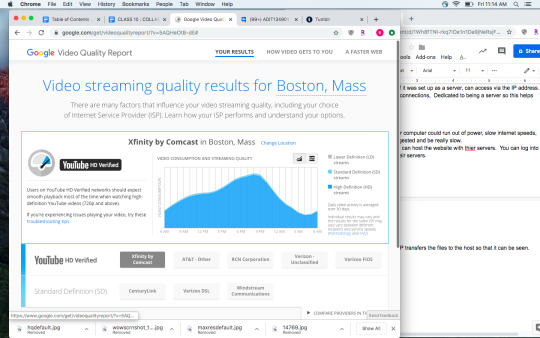
While ISP is the important factor to get you connected to the internet. Your computer connects to a router, which connects to an ISP, which then sends data to a Server. This server then sends the data back through that chain to send you the packet that you need to your computer. Packets are the file broken up into smaller pieces so they are more manageable. If packets did not exist, files would be way too large.
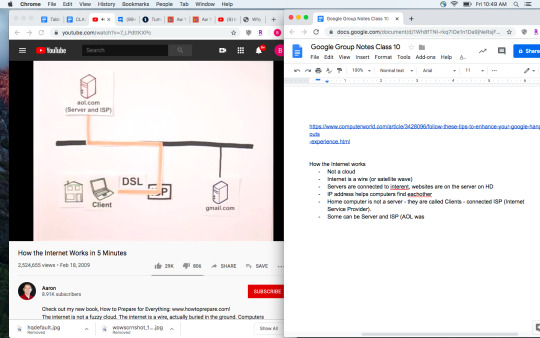
Sometimes, like the AOL example above, ISPs are Website Servers and ISPs. Google is not an ISP as they do not provide internet, they are a server.
When packets are sent, they are sent to the router, and then routed to the correct computer. This helps to prevent the wrong computer from getting the data you were looking to get. This happens as each routing process adds a layer of data so that when the packets return it knows where to go. IP addresses are like mailing addresses and this helps to get the correct information on where it is going.
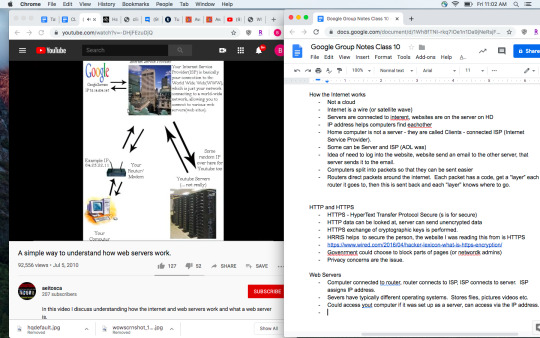
Websites that are visited, travel through ports in the router, allowing the data to be sent from the server to the router to the computer. Of course one needs an ISP to do this (otherwise it would not be on the internet, just on a network).

Websites, which are hosted on servers, are on servers for the reason that a home computer would not want to host a website. This is because the home computer is not set up to run a website all the time. If there was a power outage, or the ISP was too slow, the website run off the home computer would crash. Server sites, like godaddy.com, offer a service where your website is hosted. To connect and work on the website, FTP (File Transfer Protocol) is used. By connecting to the Server, changes can be made to the website. Since the website is hosted, one gets to take advantage of servers that are designed to run websites so their speeds are much faster. On top of that the servers are designed mainly to store and send data so they are a specialized computer designed to host data. This make for a faster website.
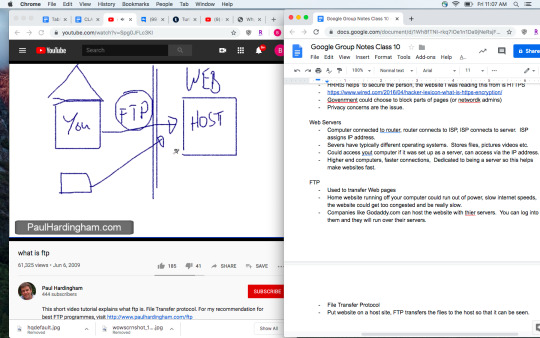
Websites can be secured, or encrypted. HTTP (Hypertext Transfer Protocol) is the protocol that sends data from a website to your computer. This information is visible, unless it is secured. This is where the HTTPS comes in (the S stands for secure). When the data is encrypted, it is harder for people to find your data making it much more private.
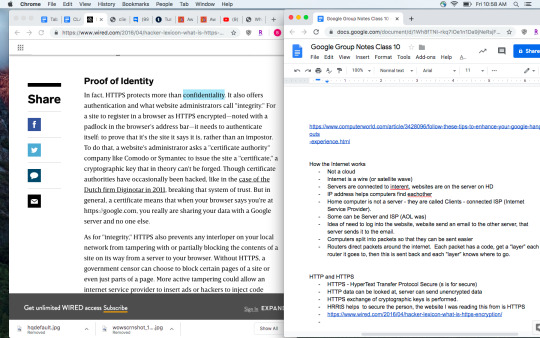
0 notes
Text
Security & Privacy: A VPN Can Help Keep Your Activities Private
Security and Privacy are two vitally important components of any successful society. They are even more important in today’s connected world where we carry computers in our pockets and share all our details on social networks.
This section of Pocketnow is devoted to why security and privacy are important, how you can protect yourself in today’s connected world, and which pitfalls you need to be aware of and avoid – with the objective of helping you and your loved ones stay safe in an ever-changing world.
~
As I mentioned in our introductory article, security is an integral, foundational component of any strong society. As a review, security is the state of being free from danger or threat. The way we realize it is through privacy – the state or condition of being free from being observed by other people.
In recent news, a rule change in these United States may allow our very own internet service providers (ISPs) to resell the information about the activities we undertake while utilizing their services. The implications of this are staggering.
Or are they? We’ll come back to that in a moment.
Virtual Private Networks
This is where VPN can help – but it’s not a cure-all.
When you connect to WiFi, you probably know better than to connect to an unencrypted access point. Doing so exposes all your web traffic to anyone within several hundred feet. To “secure” this, various encryption protocols have been released (WEP, WPA, WPA2, etc.). No encryption scheme is 100% secure, but the harder you make it for others to snoop, the more likely it is they’ll search out easier targets. Even on a properly secured wireless network, the person providing that network can still snoop on your traffic.
VPN – Virtual Private Network – is a method through which the network connection on your mobile device connects to a VPN server somewhere in the world. All your traffic is routed through this “pipe” to their computers.
Traffic sent between your device and your VPN provider is supposed to encrypted – but not all are. Do your homework first. This way, even if you are connecting to an open WiFi network, your traffic is encrypted from casual snoopers, and it’s encrypted from the person providing that WiFi network, too. Bonus!
The catch here is that your network traffic has to pop out of the VPN tunnel somewhere, and at that point it’s unencrypted. What’s more, your VPN provider is still subject to subpoenas, warrants, National Security Letters, and “cooperation agreements” with law enforcement agencies. If they’re logging traffic, that VPN endpoint is now a honeypot – instead of going after a cellular provider, your college campus, your employer, and your home internet service provider to “investigate” your traffic, now they need only go one place: your VPN.
Some VPNs do not log traffic. I’ve been using IPVanish, StrongVPN, and NordVPN over the last several months (IPVanish and StrongVPN accounts were provided to me for free in exchange for my honest review). Each offers a different set of features, and each come with a different cost. I’ve been most impressed with IPVanish, which works on my Windows 10 laptop, my iPhone, and my Android.
While a VPN is by no means a “cure-all” or “magic bullet” in our quest for privacy, getting the right one to suit your circumstances can go a long way to helping.
Advertising
Don’t be shocked. This isn’t anything new.
Yes, I agree that it’s a breach of privacy, but it’s something that’s been done by Google, Facebook, Yahoo!, MSN, AOL, Prodigy, CompuServe, GeoCities, and any number of content and service providers who came before them.
It’s called “advertising”.
Loyalty Cards
When I buy groceries or auto parts, I use their “loyalty card” to get “special discounts”. When I buy movie tickets or concessions, I use their loyalty card to get special discounts. When I buy gasoline, I use their loyalty card to get anywhere from three- to five-cents off every gallon.
By doing so, I am voluntarily giving these resellers an account number which uniquely identifies the purchaser as me. They can know the items I purchased, they can know the locations where I made the purchases, and they even know when I made those purchases.
I trade all that for three cents off every gallon of gasoline, or for a “special discount” on each loaf of bread. Where’s the outrage there?
Cookies
No, not that kind of cookie.
Websites are what we call “stateless” applications – at the core, a web page is just a document which references assets (images, sounds, styles, fonts, etc.) and has no idea who you are. Everyone who asks for a page the same basic document. That’s got some obvious limitations.
Sites like Gmail, Facebook, your bank, and any others to which you must login have to know who you are – and keep track of who you are between pages that are served.
You wouldn’t want your bank account shown to someone else, right?
One of the ways websites accomplish that is through cookies. These are small files which are held on your computer by your web browser and help identify you to the server from which they’re served.
While this works fairly well for social networks, email clients, banks, and others, advertisers have figured out how to use them to track you between any sites that display ads from that advertiser.
A VPN won’t help protect you against ads or cookies, but a VPN may help keep your everyday traffic a little more private, and will help mitigate any concerns you have over that FCC rule change, a school who monitors their network, or even an employer that wants to make sure you’re following their “acceptable use” policy.
No Free Lunch
Lastly, and this isn’t just relegated to VPNs, as the old saying goes:
There is no such thing as a “free lunch”.
In general, if something is “free”, it usually is far too expensive to consider. This is especially true of VPN providers. Do your research, find a good one, then pay them for their services.
After all, if something is “free”, it’s highly probable that you are the commodity that’s being sold – your demographics, your eyes, your mind, your privacy.
~
Stay tuned! Each week we will cover another topic pertaining to your privacy and security. TOR, HTTPS/SSL, chat services, and more are coming your way!
Source link
0 notes
Text
Server Routing Protocol Assignment Help
http://computernetworkingonlinehelp.com/ServerRoutingProtocol.php Server Routing Protocol (SRP) is the proprietary network protocol used to transfer data between a Server and the Research in Motion BlackBerry infrastructure. We have ability to deal with Server Routing Protocol assignment help, Server Routing Protocol homework help and even Server Routing Protocol project help. We cater 24x7 hour customer service round the clock with 100% assistance and satisfaction. Here at Computernetworkingonlinehelp.com we solve the problems regarding your Server Routing Protocol Assignment and Server Routing Protocol homework from various standards like colleges, university, PhD and various other research levels. Our Professionals are Master or PhD degree holders in the field of Overlay Network Server Routing Protocol assignment and Server Routing Protocol homework from top ranked institutions, universities and colleges with a year of experience in imparting their services in the field of Computer.
0 notes
Text
Server Routing Protocol Homework Help
http://computernetworkingonlinehelp.com/ServerRoutingProtocol.php
Server Routing Protocol assignment help| Server Routing Protocol homework help| Server Routing Protocol online tutor
We provide the homework and assignments solution with no plagiarism and with reference styles Harvard, APA, AMA, MLA and IEEE. Computernetworkassignmenthelp.com imparts our online Assignment service on reasonable prices. In case you want to assist any type of help regarding your Server Routing Protocol assignment and homework then knock us at Computernetworkingonlinehelp.com. Here we give the perfect solution of your problems before the deadline given by you.
#Server Routing Protocol Homework Help#Server Routing Protocol Assignment Homework Help#Server Routing Protocol Assignment Help#Server Routing Protocol Online Help#Server Routing Protocol Project Help#Server Routing Protocol Homework Help Experts
0 notes